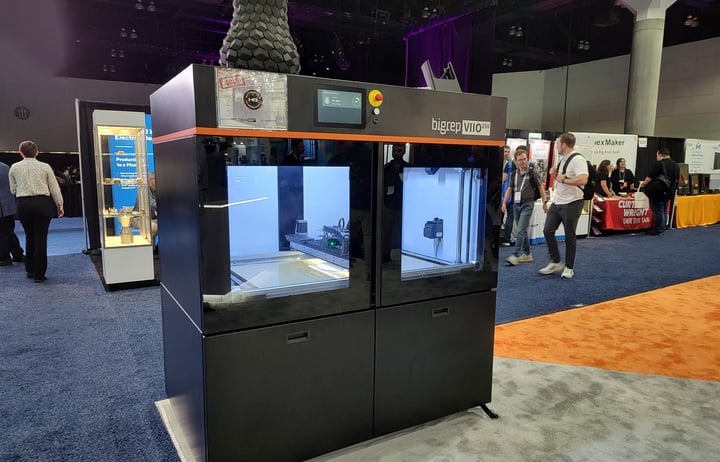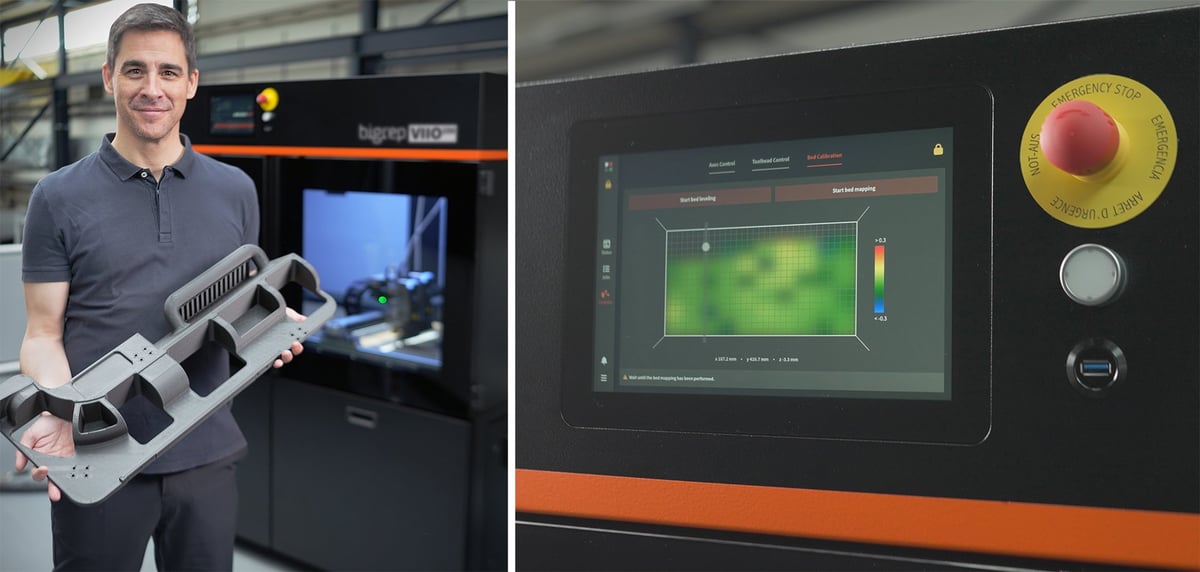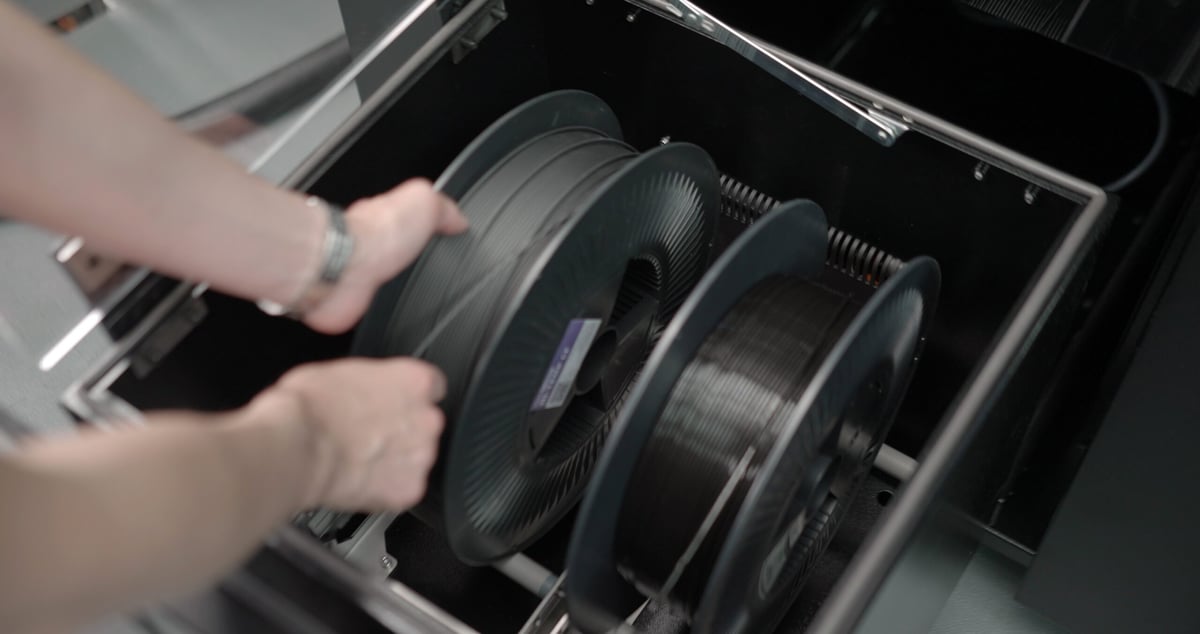Over the past year, we’ve heard a lot about new printers offering fast, accurate 3D printing of tools, fixtures, and prototypes in engineering-grade materials. Markforged launched its FX10 for this purpose and so did Stratasys with its F3300, Aon3D with its Hylo, and BCN3D with its Omega 160.
So what does the new industrial, heated-chamber, FDM from BigRep bring to the table? Quite a bit, as it turns out.
First, of course, is size. BigRep is a large-scale printer maker. The new BigRep Viio 250’s print volume at 1,000 x 500 x 500 mm is larger than the others mentioned above. There’s also a novel backup extruder functionality called Relay Mode that enables a standby extruder to take over should a clog or malfunction happen with the first extruder. Extending uninterrupted printing even more is a new auto filament spool switch-over feature that detects imminent material outages and loads the next of four 8-kg spools.

There’s also three times the number of sensors as other BigRep machines. These constantly collect printer data that’s used not only in quality control of printed parts, but in predictive maintenance and ensuring the machine is running optimally.
But first, let’s talk a look at why BigRep, which makes several successful large-scale printers, decided to tackle the complexity of heat. We caught up with the company’s Managing Director Sven Thate at the recent Rapid + TCT expo in Los Angeles and asked him that exact question.

“We were fed up with having to tell customers that if they wanted to print Ultem or other ultra materials, we cannot offer you a solution for that,” says Thate. BigRep’s “cool” 3D printers, or those without an actively heated chamber or a super-heated nozzle, produced parts in carbon-fiber nylon, but industrial customers became increasingly interested in materials that needed the extra heat.
BigRep now, not only has the Viio 250 to offer, but last month, it launched two other industrial, high-temperature FDM that we wrote about in June. These other machines, the Altra 280 and the Ipso 105, were added to the menu via acquisition of the Austrian firm Hage3D in 2023. They are both smaller than than the Viio 250 and don’t have all the Viio features that BigRep has been developing over the past two years, but they have other complementary bells and whistles, the company says.

Step Up From Your Desktop FDM
“Everybody who 3D prints, at a certain point, starts to think bigger,” says Thate. “They ask themselves, why should I glue stuff together instead of printing it just in one piece. We see a huge wave of opportunity coming our way where customers graduate from the desktop into the more professional industrial environment.”
BigRep machines have always been focused on both productivity and ease of use, Thate says, but the Viio 250 is the most automated machine yet from BigRep.
The the HMI (human machine interface), which includes the machine’s graphical user interfaces (GUIs), touchscreens, buttons, and other interactive components are available in multiple languages to guide users through the print process with animated walkthroughs. BigRep says any user can easily check, prioritize, and line up print jobs. Alerts are designed to ensure efficient workflow management.
“Solid hardware on a 3D printer is very important, but good prints come from the brain of the machine, which is the controls infrastructure,” says Thate.
The brain of the Viio 250 is fed by sensor data, as we mentioned. But what does BigRap do with all that sensor data?
“We are a very data driven company and we use data coming back from the machines to make them better,” says Thate. “We analyze what we see from successful customers, what they do with the machines, and what materials they print with.”
BigRep’s vision is to have an intersection of additive manufacturing and AI to really make sense of the data that’s collected, and in the end, create a machine that’s as easy to print with as a 2D printer.
“We’re not there yet, but definitely data will help us to get close to that to that ultimate goal.”

Open Materials
There’s a movement toward using pellet material in high-temperature FDMs, such as the Industry Magnum, the WASP 3MT HDP, and the new Ext 800 Titan Pellet. BigRep, however, decided to stick with filament for the BigRep Viio 250, but at least it’s an open material platform.
“We are competing even more in the direction where Stratasys is now. They’re definitely the leader in the FDM, but we’re offering a hot solution for customers who want something open in terms of both software and materials,” says Thate. There’s an OpenAM license for select Stratasys FDMs, but proprietary materials are the typical option.
“Obviously, we love to sell our bigger branded materials (BigRep ASA, BVOH, Hi-Temp, Hi-Temp CF, PA12 CF, PA6/66, PETG, PLA, PLX, Pro HT, TPU 98A) because they have been chosen for a reason and work best on our machines because they come with all the parameter settings that make the customer successful from day one,” says Thate. “But if they have a very special need, perhaps wood fiber reinforced eco material and they have a huge application, we’ll help them to get those materials going on our open system.”
To keep all of your industrial materials in top form, BigRep is working on a new drying and conditioning unit, so stay tuned for more details as that unit becomes available.
Want to read more about large scale FDM? Check out our guide below.
_____________________________
Never Miss Any News:
License: The text of "BigRep Launches Another Large-Scale Hot FDM, the Viio 250" by All3DP Pro is licensed under a Creative Commons Attribution 4.0 International License.

